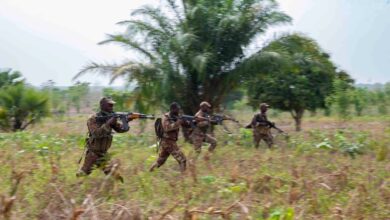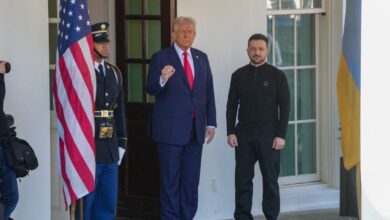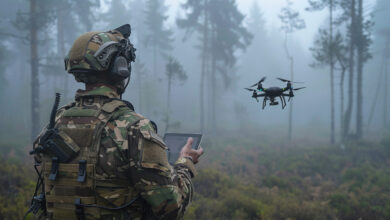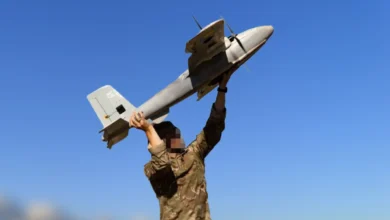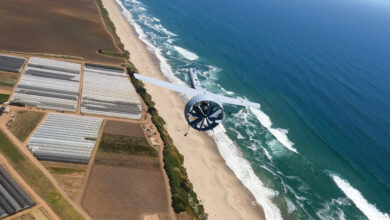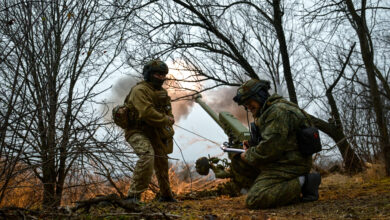
Earlier this month, a Ukrainian MiG-29 pilot was killed in combat after receiving US flight training. A few familiar with his backstory have come forward, hoping their voice can inspire change to a US Defense Cooperation system that desperately needs it.
The US is the world’s largest provider of defense cooperation. Its training programs are massive, with hundreds of slots for foreign students. Because of this size and scope, the system operates as expected: cumbersome, entrenched, and unbending, marred in heavy policy and interagency clashes.
It also contributed to the recent death of a Ukrainian MiG-29 pilot.
Vladyslav in US Flight School
Meet Captain Vladyslav ‘Nomad’ Savieliev. He was a Ukrainian pilot fighting against Russia’s illegal invasion. He was married and had a beautiful little daughter. Those who knew him said he was a great guy. He was recently killed flying a MiG-29 for his nation. How he died isn’t the issue; the backstory is.
Vladyslav had been flying MiG-29s for a while, conducting life-and-death combat missions in Crimea, Luhansk, and the Donbas. According to sources, he’d flown down to 30 feet (9 meters) at over 600 knots, dropping ordinance while defending his jet against some of the world’s most advanced air defenses.
In 2021, he was selected for the US Security Cooperation’s Aviation Leadership Program (ALP). For most foreign pilots, a US-funded language training and flight school would be a dream come true. For Vladyslav, it was frustrating. He’d rather be in Ukraine, fighting for his nation.
After ALP’s language school and other training, Vladyslav arrived at Columbus Air Force Base. Per the syllabus, he attended Undergraduate Pilot Training, learning the propeller-driven T-6 Texan. The T-6 Texan is a good training platform, and it’s a great fit for most ALP candidates. But Vladyslav was far from “most” candidates.
Vladyslav had racked up far more flying hours than his peers, and those hours were intense combat flying, not training.
As one of his US Air Force flight instructors said, “In all the foreign students I’ve trained, I never saw one that had more combat hours than myself and against advanced Russian air threats. Threats only seasoned US fighter pilots train to face. Vladyslav wore his wings and MiG-29 Fulcrum patches with honor. He deserved to.”

Diminishing MiG-29 Skills
Vladyslav’s instructors stated his skills were well ahead of other students. The hours he spent in the T-6 were a waste of time. For example, his syllabus included low-level flights in the T-6 at 210 knots, an arduous task for new pilots. In combat dodging Russian defenses, Vladyslav had flown low-level at nearly three times that speed.
As one instructor said, “I flew with him on a low-level training sortie. What was I supposed to teach him? The guy was more advanced than any foreign student I’d ever seen. T-6 flying was diminishing his MiG-29 flight skills, not improving them.”
Noteworthy, T-38 twin-engine jet trainer aircraft are co-located on Columbus Air Force Base with T-6 Texans, used for Introduction to Fighter Fundamentals (IFF). The IFF is an eight-week course that teaches “newly graduated pilots selected to fly fighters into fighter wingmen.”
Such a class may not have been up to Vladyslav’s speed but far better than the nine-month one he was assigned to. Ukrainian Air Force officials state this follow-on class was not possible for Vladyslav.
Throughout the training, Vladyslav was continually frustrated. All he wanted to do was get back. Vladyslav asked the US Air Force and Ukrainian Armed Forces to shorten his course and send him home. Ukrainian officials confirm both denied the request.
Back in Ukraine
Vladyslav graduated on March 24, 2023. With his diploma in his hand and US Basic Pilot Wings patch on his chest, Vladyslav packed up his family and finally returned to Ukraine.
Unfortunately, his perfectly honed skills of combat flying a MiG-29 were long gone, and Vladyslav’s “new norm” was peacetime flying of a propeller-driven trainer.
On June 2, the Ukrainian Ministry of Defense released a statement saying Vladyslav ‘Nomad’ Savieliev was killed in a combat aviation incident.
Given the graduation date, the time to move back to Ukraine, and the date he was killed, Vladyslav may not have received the refresher training required. Requests on this issue to the Ukrainian Armed Forces went unanswered.
Assuming he didn’t receive enough training, the Ukrainian Air Force also holds some blame for his death. It’s important to remember, however, that Ukraine is at war. Every minute of fighter flight operations is precious. From a friend’s social media posts, it seems Vladyslav “rushed” back into combat, suggesting his wishes to fight ASAP were granted.
What Could USAF Have Done Differently?
Sadly, that’s Vladyslav’s story. But what could the US Air Force have done differently? Under current constructs, very little. Those selected for the Aviation Leadership Program only fly one cookie-cutter syllabus, eliminating perceptions of favoritism among foreign participants.
In fairness, ALP is an excellent program. Nations realize the intrinsic value of sending their students to the US. Friendships are made, there is a familiarization with US customs and culture, and a bond of cooperation is fostered.
So why is Vladyslav’s case different? Simple: ALP is a peacetime construct, whereas Ukraine is at war.
The country’s time and resources are limited, and Ukrainians face an ever-present fear their nation be erased from earth. The US Air Force should have identified the uniqueness of this situation. Local leadership could have shifted Vladyslav to a hybrid syllabus with T-38s. Clearly, this is nonstandard, but then again, so is a nation under siege.
Ironically, changes to ALP would likely be just as rare as a recent graduate being killed in combat weeks after completing the program.
Accelerate Change
Changes to the syllabus may have bucked against massive bureaucracy, but here is the rub. The current US Chief of Staff, General Charles ‘CQ’ Brown, has aggressively pushed the narrative to “Accelerate Change or Lose.” Vladyslav’s situation could have been a phenomenal success story. Tragically, it’s on the other end of the spectrum.
At a US national security level, there’s a greater concern. While the US military transitions to the fifth-generation fighters to deal with advanced Russian and Chinese air threats, a fourth-generation MiG-29 pilot was in the US with intimate knowledge of these threats.
Further, he’d been flying in and surviving them in an older airframe. He and his colleagues developed tactics, techniques, and procedures to succeed in Ukraine’s contested skies. Vladyslav’s knowledge would have been invaluable.
None of this will bring Vladyslav back, nor will it ease the pain of his family and friends. As one of his instructors said, “I think some of us here believe the US is partly responsible for Vladyslav’s death.”
Recently, Gen CQ Brown has been nominated for the Joint Chairman position. Selfishly, I’d rather see him remain in the Air Force and address this issue, continuing to push his “Accelerate Change” initiative. Now that he’s likely to be the next Chairman, maybe he can do everything in his power to care for Vladyslav’s family, potentially asylum, residency, or citizenship.
Vladyslav may not have been a US Air Force pilot, but he and his family deserve the services, care, and comfort. Clearly, a burdensome peacetime policy did Vladyslav no favors.
For those wishing to contribute to a fund for Vladyslav’s wife and daughter, donations can be made here.
 Colonel (Ret) Jeffrey H. Fischer (www.jeffreyhfischer.com) is a 30-year military aviator and electronic warfare officer with seven combat tours in Iraq, Afghanistan, and the Balkans. He flew both the air force’s EC-130h compass call and the EA-6B prowler while on a joint exchange with the US Navy, seeing considerable combat time in both airframes.
Colonel (Ret) Jeffrey H. Fischer (www.jeffreyhfischer.com) is a 30-year military aviator and electronic warfare officer with seven combat tours in Iraq, Afghanistan, and the Balkans. He flew both the air force’s EC-130h compass call and the EA-6B prowler while on a joint exchange with the US Navy, seeing considerable combat time in both airframes.
Jeff served as a defense official at the US Embassy in Kosovo. A graduate of the National Defense University, he is the author of Live Range, Balkan Reprisal, and Afghan Ghosts, all available globally on Amazon.
The views expressed in this article are those of the author and do not reflect the official policy or position of the Department of Defense or the US Government. Cleared for release by DoD Office of Prepublication and Review 23-S-2370.
The views and opinions expressed here are those of the author and do not necessarily reflect the editorial position of The Defense Post.
The Defense Post aims to publish a wide range of high-quality opinion and analysis from a diverse array of people – do you want to send us yours? Click here to submit an op-ed.


